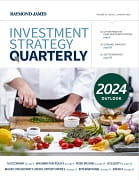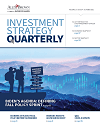Market performance in a presidential election year
Managing Director, Washington Policy Analyst Ed Mills provides an update on his team's 2024 election outlook and other key issues Washington D.C. will tackle.
To read the full article, see the Investment Strategy Quarterly publication linked below.
Key takeaways:
- While the most likely scenario remains a rematch of the 2020 election, there seems to be a nagging feeling that something could happen to reset the race and produce an unexpected outcome.
- We would not be surprised to see 2024 track traditional presidential election years, where there are pockets of weakness during periods of the greatest uncertainty, but a market rebound and renewed strength as we receive clarity on key issues.
- Washington D.C. will have an important to-do-list in 2024, including government funding and responding to a changing global security environment.
Presidential election years usher in considerable uncertainty. While the most likely scenario remains a rematch of the 2020 election, there seems to be a nagging feeling that something could happen to reset the race and produce an unexpected outcome. This uncertainty, the potential for surprise and the polarized nature of the political environment may cause investors to be cautious in the upcoming election year. Adding to this uncertainty is lingering geopolitical risk, concerns over the trajectory of the debt and deficit, recession risk, and unresolved government funding decisions. From a market perspective, we would not be surprised to see 2024 track traditional presidential election years, where there are pockets of weakness during periods of the greatest uncertainty, but a market rebound and renewed strength as we receive clarity on key issues.
How could the electoral calendar impact market performance?
The state of play for the 2024 race will remain fluid ahead of Election Day, but a 2020 presidential rematch remains the most likely situation at this stage of the race. However, many unanswered questions remain in the months ahead, with implications for market sentiment at various turning points. Overall, election years have historically seen the second lowest market returns of the presidential term cycle, with an average monthly return of 0.54%. However, markets quickly play catch-up after election year uncertainty is resolved, averaging a monthly return of 1.28% during the year after the election. Midterm election years are the weakest point for markets in a presidential term, historically seeing average monthly returns of 0.3% regardless of the party in control of the White House.
As we enter January, we would highlight to investors that the beginning of election years (January-March) historically sees negative market returns as the primary process – and associated political volatility – hits its peak, with average monthly returns of -0.44%. The primary cycle will kick off on January 15 in Iowa for Republicans and the first ‘official’ primary will be on February 3 in South Carolina for Democrats. Two key measures of strength for an incumbent president are his favorability ratings and the right track/wrong track trajectory of the country. In each of these measures, there are warning signs for President Biden and we will be watching to see if this provides an opening for weaker than expected primary election results for Biden. Biden has two long-shot candidates running against him, but anything less than 75-80% support will set off renewed alarm bells for his campaign.
As Republican voters head to the primaries, Donald Trump’s continued strong polling numbers suggest his likely nomination to the Republican presidential ticket, but his legal challenges remain a significant wildcard ahead of the primary process. If there is a surprise in the Republican primaries, we would need to see voters coalesce around a clear alternative to former President Trump, picking up momentum in the early states. Should Trump emerge as the Republican nominee, a key debate for the general election will be how much of the election is a referendum on Biden versus Trump, as Trump has similar unfavorable ratings to Biden.
Key electoral inflection points for the market: March, October-November
March remains an important inflection point in the electoral calendar, with 34 primary elections, including 16 states holding their primaries on Super Tuesday. The end of the month will provide important clarity on who the prospective nominees might be, with more than half of both parties’ delegates awarded ahead of the Republican convention in July and Democratic convention in August. Given this clarity, the period between March and October during an election year historically has seen positive returns (0.97% average monthly returns). Any remaining uncertainty over nominees should be resolved at the nominating conventions – July 15-18 for Republicans and August 19-22 for Democrats. Beyond first quarter volatility, the most significant downside risk is seen in the immediate run up to the election (October through Election Day), with an average monthly return of -1.27%.
While the race is likely to remain close until the polls open on November 5, historically we have seen more market weakness in the run up to a Democratic presidential victory versus a Republican presidential victory, but these numbers are a bit skewed by the impact of the global financial crisis in 2008 preceding President Obama’s victory. Despite this pre-election volatility, markets tend to quickly play catch-up and see an outsized market return. If Democrats retain the White House, we expect to see a greater positive rotation in the first 100 days of a Democratic presidency compared to a GOP victory – on average, markets rise 1.75% monthly the year following a Democratic presidential win, compared to 0.88% for Republicans. Given this historical correction, we would caution investors to avoid using the election as too much of a catalyst for investment decisions.
What else does Washington D.C. need to achieve in 2024?
Aside from electing a president and a new Congress, D.C. will enter 2024 with an important to-do list, including government funding and responding to a changing global security environment. A first-mover for investors to watch will be the government funding debate, with new deadlines set for January 19 for four of the twelve appropriations bills and February 2 for the remaining eight bills. Temporary government shutdowns and triggers of 1% across-the-board spending cuts remain possible, which could add to market volatility in the first quarter. While near-term economic concerns have been raised about a potential slump in near-term fiscal support given the spending cut discussions, we would point to the implementation of major infrastructure legislation (including the bipartisan infrastructure law and the Inflation Reduction Act) which will continue to be deployed and have significant macroeconomic impacts.
Geopolitics will be another priority for D.C. to address throughout 2024, with parallel wars in Ukraine and in Israel/Gaza alongside ongoing Indo-Pacific security concerns likely to shape key legislative, political and regulatory outcomes throughout the year. Amid heightened concerns around fiscal spending and under the leadership of new House Speaker Mike Johnson, additional military aid for Ukraine will continue to come under close scrutiny in the halls of Congress. The pairing of funding for Ukraine and Israel with border security provisions will continue as another first-mover theme once Congress returns. Despite the political process likely slowing down the passage of the supplementary defense funding bill, we continue to expect to see a long-term setup that supports higher defense spending given national security’s reemergence as a core legislative and regulatory theme in D.C.
Finally, the U.S./China relationship will also remain in focus in 2024 as D.C. and Beijing try to restabilize the bilateral relationship through strengthened channels of communication. Reactions to further national security initiatives (such as expanded restrictions on the export of advanced technology) can generate new geopolitical risk for investors to monitor, but will also serve as a test of the new guardrails placed on escalation risk by the renewed bilateral contacts. A hawkish tilt in Congress (compared to the White House) can drive additional market-impactful policy actions out of D.C. that place further restrictions on China-related economic activities.

Read the full
Investment Strategy Quarterly
All expressions of opinion reflect the judgment of the Chief Investment Office, and are subject to change. This information should not be construed as a recommendation. The foregoing content is subject to change at any time without notice. Content provided herein is for informational purposes only. There is no guarantee that these statements, opinions or forecasts provided herein will prove to be correct. Past performance may not be indicative of future results. Asset allocation and diversification do not guarantee a profit nor protect against loss. The S&P 500 is an unmanaged index of 500 widely held stocks that is generally considered representative of the U.S. stock market. Keep in mind that individuals cannot invest directly in any index, and index performance does not include transaction costs or other fees, which will affect actual investment performance. Individual investor’s results will vary. Investing in small cap stocks generally involves greater risks, and therefore, may not be appropriate for every investor. International investing involves special risks, including currency fluctuations, differing financial accounting standards, and possible political and economic volatility. Investing in emerging markets can be riskier than investing in well-established foreign markets. Investing in the energy sector involves special risks, including the potential adverse effects of state and federal regulation and may not be suitable for all investors. There is an inverse relationship between interest rate movements and fixed income prices. Generally, when interest rates rise, fixed income prices fall and when interest rates fall, fixed income prices rise. If bonds are sold prior to maturity, the proceeds may be more or less than original cost. A credit rating of a security is not a recommendation to buy, sell or hold securities and may be subject to review, revisions, suspension, reduction or withdrawal at any time by the assigning rating agency. Investing in REITs can be subject to declines in the value of real estate. Economic conditions, property taxes, tax laws and interest rates all present potential risks to real estate investments. The companies engaged in business related to a specific sector are subject to fierce competition and their products and services may be subject to rapid obsolescence.

